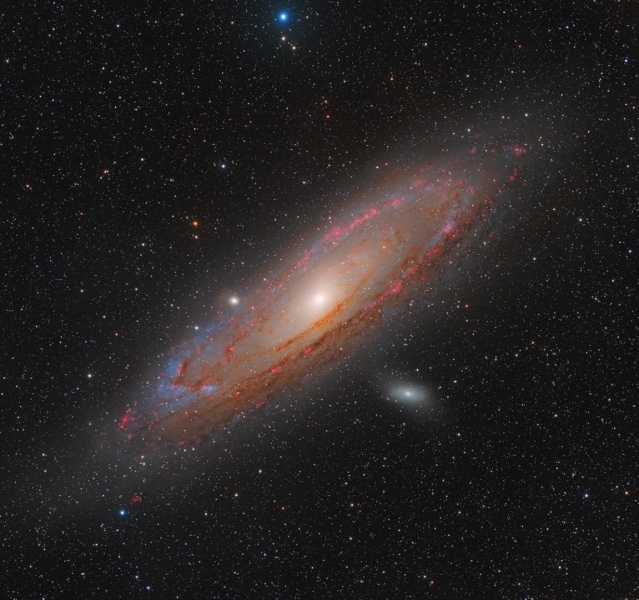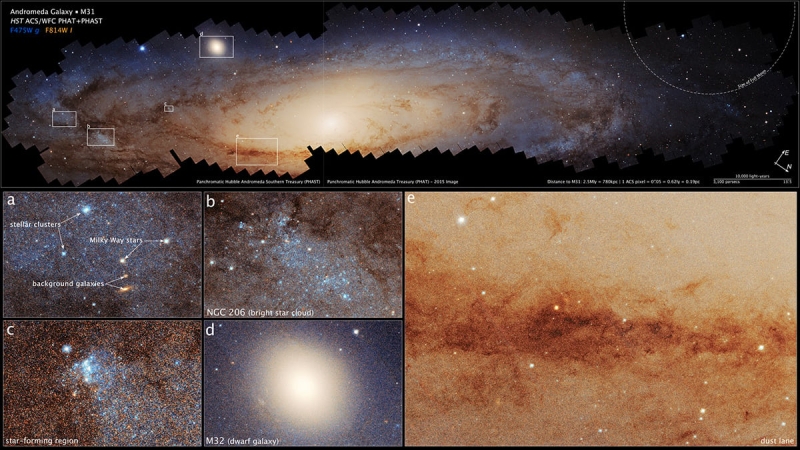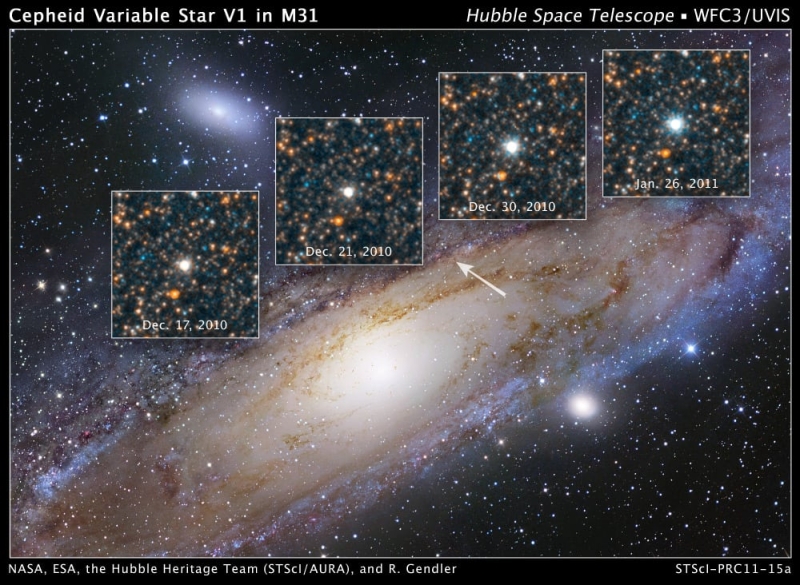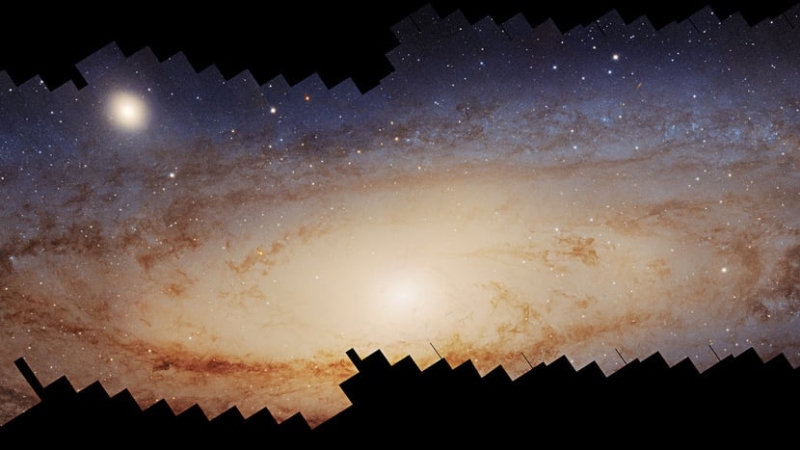Contents
In January 2025, NASA and ESA released the most detailed image ever captured of the Andromeda Galaxy (M31) using the Hubble Space Telescope. This breathtaking mosaic, created from over 600 individual exposures taken over a decade, spans 2.5 billion pixels and reveals the glow of nearly 200 million stars across Andromeda’s vast disk. This image is more than just a stunning visual—it is a scientific milestone. By analyzing its intricate details, astronomers can gain deeper insights into the galaxy’s structure, star formation, and evolution. Andromeda is the closest spiral galaxy to the Milky Way, making it an essential subject for understanding how galaxies grow and interact over billions of years.
The Andromeda Galaxy: A Cosmic Neighbor
Located approximately 2.5 million light-years from Earth, Andromeda is the largest galaxy in the Local Group and has an estimated trillion stars. With a diameter of about 220,000 light-years, it is more than twice the size of the Milky Way. Its proximity allows astronomers to study its structure in remarkable detail, providing a valuable comparison to our galaxy.
One of the most fascinating aspects of Andromeda is its eventual fate. Astronomers predict that in about 4.5 billion years, it will collide and merge with the Milky Way, forming a massive elliptical galaxy. Studying Andromeda today helps scientists model this future event while also providing insights into the evolution of large galaxies across the universe.

Andromeda galaxy, as seen from earth-based telescope
How Hubble Captured This Historic Image
Creating this detailed portrait of Andromeda was a monumental task. Between 2012 and 2022, the Hubble Space Telescope conducted over 1,000 orbits around Earth to collect the necessary data. Using its Advanced Camera for Surveys (ACS) and Wide Field Camera 3 (WFC), Hubble captured overlapping sections of the galaxy, ensuring that even its faintest details were recorded.
Each section was imaged multiple times at different wavelengths, allowing astronomers to study a range of features, from bright star-forming regions to faint dust lanes. The vast amount of data collected over the decade required extensive processing. Astronomers meticulously aligned and combined the images, correcting distortions to create a seamless panoramic view. When the final mosaic was completed and released in January 2025, it became one of the most detailed and comprehensive images of any galaxy ever taken.

This is the largest photomosaic ever assembled from Hubble Space Telescope observations. Credit: NASA, ESA, Benjamin F. Williams (UWashington), Zhuo Chen (UWashington), L. Clifton Johnson (Northwestern), Joseph DePasquale (STScI)
Revealing Andromeda’s Structure
The clarity of this image allows astronomers to examine Andromeda’s structure with unprecedented detail. At the galaxy’s heart, the dense central bulge glows with the light of older stars, forming a bright and compact core. Moving outward, the spiral arms emerge, filled with young, hot stars that illuminate vast clouds of interstellar gas and dust. These star-forming regions appear in shades of blue and pink, highlighting areas where new stars are actively being born.
Dark lanes of dust weave through the galaxy’s disk, creating intricate patterns that contrast against the bright starlight. These filaments of interstellar material are crucial for star formation, as they provide the raw materials needed for new stars to emerge. Surrounding the visible disk, the faint glow of Andromeda’s stellar halo extends far beyond the main structure. This diffuse collection of older stars holds important clues about Andromeda’s past mergers and interactions with smaller galaxies.

Interesting regions from the photomosaic. Credit: NASA, ESA, Benjamin F. Williams (UWashington), Zhuo Chen (UWashington), L. Clifton Johnson (Northwestern), Joseph DePasquale (STScI)
Scientific Insights from the 2025 Image
Beyond its breathtaking appearance, this image is a powerful tool for scientific research. The ability to resolve individual stars across such a vast region allows astronomers to map Andromeda’s stellar populations in unprecedented detail. By analyzing the colors and brightness of these stars, researchers can determine their ages and chemical compositions, helping to piece together Andromeda’s star formation history.
One of the most significant discoveries made possible by this image is new evidence of past galactic mergers. The distribution of stars and star clusters suggests that Andromeda has absorbed multiple smaller galaxies over billions of years. These past interactions have shaped its current structure, leaving behind subtle imprints that can now be studied with greater accuracy.
The motion of stars within the galaxy also provides crucial data for understanding dark matter, the invisible substance that makes up most of Andromeda’s total mass. By tracking how stars orbit within the galaxy, astronomers can refine models of dark matter’s influence on galactic structure and behavior. This information helps improve our understanding of how dark matter shapes the universe at large.
Another major benefit of this image is its role in predicting the eventual collision between Andromeda and the Milky Way. By analyzing the galaxy’s motion, astronomers can create more precise simulations of how the two galaxies will interact when they merge in the distant future. These studies contribute to a broader understanding of galaxy collisions and how they drive cosmic evolution.

Cepheid Variable Star V1 in Andromeda Galaxy. Credit: NASA, ESA, Hubble Heritage Project (STScI, AURA), Robert Gendler
Hubble’s latest image of Andromeda is an extraordinary achievement that combines the power of technology, science, and human curiosity. After more than a decade of observations, this 2.5-billion-pixel mosaic captures the galaxy in breathtaking detail, offering an unparalleled view of 200 million stars and revealing new insights into its structure and history. More than just a stunning photograph, this image represents a major leap forward in our understanding of galaxy formation, stellar evolution, and dark matter. It provides a wealth of data for astronomers and serves as a foundation for future discoveries with advanced telescopes. As technology continues to advance, this image will remain a crucial resource for understanding our cosmic neighborhood.
Clear skies!

